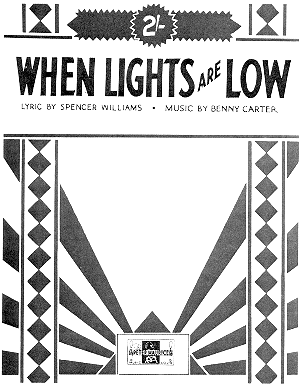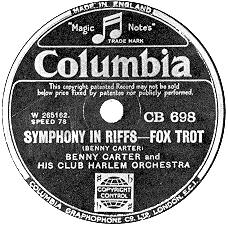

 From 1924 to 1928, Carter gained valuable professional experience as
a sideman in some of New York's top bands. He also traveled to the
midwest to work with the Wilberforce Collegians, and to Pittsburgh
for a stint with Earl Hines. Carter's recording debut came in 1928
as a member of Charlie Johnson's Orchestra, which was based in
Harlem's Small's Paradise. Two of the arrangements recorded that day
were by Carter, who had somehow managed to teach himself the craft of
arranging. Later that year, Carter joined Fletcher Henderson's
seminal orchestra, assuming the arranging duties previously handled
by Don Redman. Carter's innovative scores, particularly his writing
for the sax section, revitalized the band and, according to scholar
Gunther Schuller, "Carter was now the arranger everyone followed."
From 1924 to 1928, Carter gained valuable professional experience as
a sideman in some of New York's top bands. He also traveled to the
midwest to work with the Wilberforce Collegians, and to Pittsburgh
for a stint with Earl Hines. Carter's recording debut came in 1928
as a member of Charlie Johnson's Orchestra, which was based in
Harlem's Small's Paradise. Two of the arrangements recorded that day
were by Carter, who had somehow managed to teach himself the craft of
arranging. Later that year, Carter joined Fletcher Henderson's
seminal orchestra, assuming the arranging duties previously handled
by Don Redman. Carter's innovative scores, particularly his writing
for the sax section, revitalized the band and, according to scholar
Gunther Schuller, "Carter was now the arranger everyone followed."
In 1931, Carter became musical director of another important musical
organization: the Detroit-based McKinney's Cotton Pickers. Already
a major force on alto, he now returned to his first love, the
trumpet. Within two years, Carter was making trumpet recordings that
rivaled his alto classics. On both instruments, Carter has always
displayed a rare ability to conceive a solo as a whole, without
losing the spark of spontaneity.
 In 1932, Carter returned to New York and soon began putting together
his own orchestra, which eventually would include such swing stars as
Chu Berry, Teddy Wilson, Sid Catlett, and Dicky Wells. As was the
case with all Carter-led units, the group was known as a "musicians'
band." Unfortunately, high musical standards did not ensure
commercial success, especially during the depression, and by late
1934, Carter was forced to disband.
In 1932, Carter returned to New York and soon began putting together
his own orchestra, which eventually would include such swing stars as
Chu Berry, Teddy Wilson, Sid Catlett, and Dicky Wells. As was the
case with all Carter-led units, the group was known as a "musicians'
band." Unfortunately, high musical standards did not ensure
commercial success, especially during the depression, and by late
1934, Carter was forced to disband.
A timely invitation brought Carter to Paris in 1935 to play with
Willie Lewis's orchestra. At the suggestion of music critic Leonard
Feather, he was invited to England to serve as arranger for the BBC
dance orchestra. Carter played an essential role in spreading jazz
abroad. Over the next three years, he traveled throughout Europe,
playing and recording with the top British, French, and Scandinavian
jazzmen, as well as with visiting American stars such as his friend
Coleman Hawkins. In Holland during this period, Carter also led the
first international, interracial band.
Copyright © 1996-2003 Edward Berger